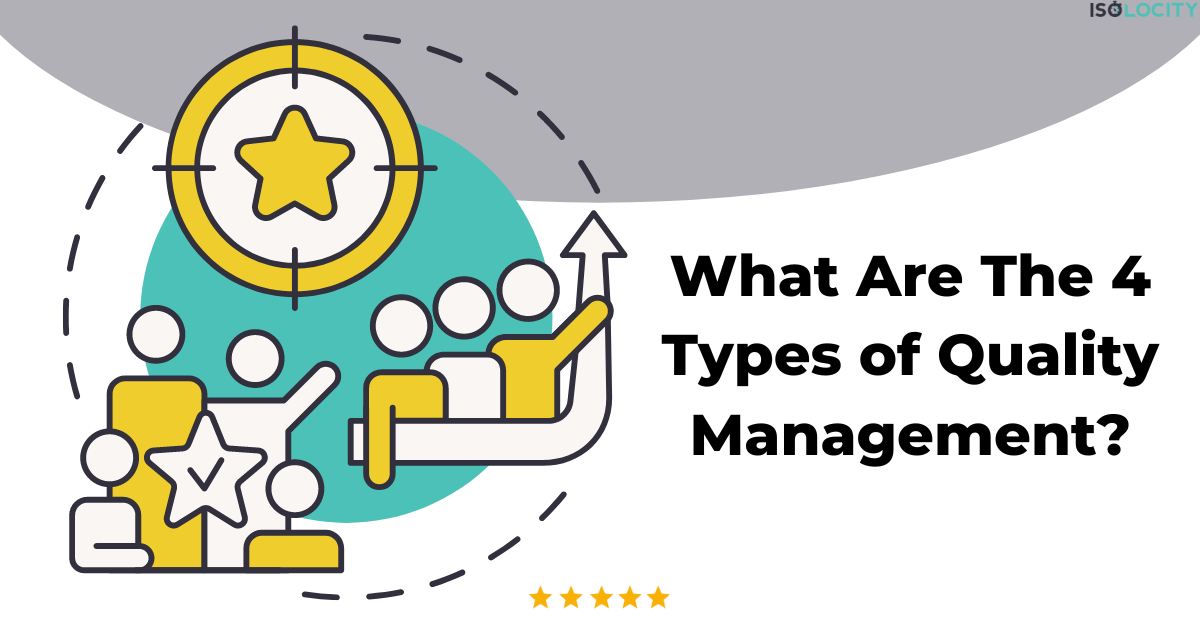Quality management encompasses various approaches and methodologies aimed at ensuring that products, services, and processes consistently meet or exceed customer expectations. In this context, people often ask us a common question:
“What are the 4 types of Quality Management?”
While there are more than 4 types of quality management, we will keep our answer in sync with that, as the question revolves around understanding 4 major types of quality management.
Need help with your quality management system? Talk to our product specialist.
Firstly, the 4 types of quality management are: 1. Total Quality Management (TQM); 2. Six Sigma; 3. ISO 9000 & Quality Management Systems (QMS); and 4. Quality Function Deployment (QFD).

Now, let’s dive deeper and understand each of these types.
Prefer video over text? Here’s a video version of the blog!
1. Total Quality Management (TQM):
Total Quality Management is a comprehensive approach that involves the entire organization in a continuous effort to improve quality at every level. Furthermore, TQM emphasizes customer satisfaction, employee involvement, and continuous process improvement.
Key Principles:
- Customer Focus: Meeting or exceeding customer expectations is a primary goal.
- Employee Involvement: All employees contribute to quality improvement.
- Continuous Improvement: A commitment to ongoing improvement of processes and products.
- Process Orientation: Emphasizing the importance of well-defined and controlled processes.
Example:
For instance, Toyota is often cited as a company that successfully implemented TQM principles. Their commitment to continuous improvement, employee involvement, and customer focus have contributed to their reputation for producing high-quality vehicles.
2. Six Sigma:
Six Sigma is a data-driven methodology that seeks to improve process efficiency and eliminate defects by identifying and removing the causes of variability. Therefore, it is based on the concept of reducing process variation to achieve higher levels of performance and customer satisfaction.
Key Elements:
- Define, Measure, Analyze, Improve, Control (DMAIC): A structured problem-solving approach.
- Statistical Tools: Using statistical methods to analyze and improve processes.
- Belt System: Classifying individuals involved in Six Sigma projects into different “belts” (e.g., Black Belt, Green Belt) based on their level of expertise.
Example:
For instance, General Electric (GE) is a notable example of a company that has embraced Six Sigma. Under the leadership of Jack Welch, GE extensively applied Six Sigma methodologies to improve processes and achieve substantial cost savings.
3. Quality Management System (QMS)
The ISO 9000 family of standards outlines criteria for a quality management system (QMS). Organizations can achieve ISO 9001 certification by demonstrating compliance with these standards, indicating their commitment to quality and customer satisfaction.
Key Components:
- Documented Processes: Well-documented and standardized processes.
- Continuous Improvement: A commitment to ongoing improvement.
- Customer Focus: Meeting customer requirements and enhancing customer satisfaction.
- System Approach: Viewing the organization as a set of interconnected processes.
Example:
For instance, Boeing, a leading aerospace company, exemplifies ISO 9001 and Quality Management Systems. The company’s commitment to ISO 9001 principles ensures:
- Documented Processes: Boeing maintains meticulous documentation for every step in aircraft design, manufacturing, and inspection.
- Continuous Improvement: Boeing embraces ongoing enhancements, incorporating new technologies and lessons learned from past projects to boost efficiency and quality.
- Customer Focus: ISO 9001 certification reflects Boeing’s dedication to meeting high-quality standards, ensuring customer satisfaction and the reliability of its aerospace products.
- System Approach: Boeing manages interconnected processes systematically, ensuring each step contributes to overall product quality and safety.
4. Quality Function Deployment (QFD):
Quality Function Deployment is a method used to translate customer needs and expectations into specific product or service features. It helps organizations prioritize design and production elements to meet customer requirements.
Key Components:
- House of Quality: A matrix that relates customer requirements to engineering characteristics.
- Customer Voice: Incorporating customer input and preferences into product development.
- Cross-Functional Teams: Collaboration across different departments to ensure all perspectives are considered.
- Continuous Communication: Ongoing communication and feedback loops to refine product development.
Example:
For instance, Apple Inc. is known for using QFD concepts to make new products (check this dissertation, page 50). Apple has made a lot of great and innovative consumer electronics by making sure that the features and design of their products are very close to what customers want.
Other related articles:
- What are the 4 components of Quality Management?
- What are the 4 pillars of TQM and Quality management?
FAQs About Quality Management:
- Q1: Are the 4 approaches to quality management incompatible with one another?
No, various approaches to quality control can work in concert with one another. On the contrary, a lot of businesses use a mix of these approaches to develop an all-encompassing quality control plan that meets their unique requirements. - Q3: Do all firms need to be certified to ISO 9001?
No, obtaining ISO 9001 certification is not required, though many businesses do it voluntarily. But obtaining a certification can boost one’s reputation, show dedication to excellence, and create business chances. - Q4: Is there a way that Six Sigma implementation can help small businesses?
It is possible to scale and modify Six Sigma principles to meet the requirements of small organizations. The secret is to apply data-driven techniques to boost productivity and quality while concentrating on the most important tasks. - Q5: How frequently should a business update the documentation for its Quality Management System (QMS)?
It is important to periodically evaluate and update QMS documentation to take into account modifications to procedures, laws, or technology. This guarantees the QMS’s continued applicability and efficacy.




